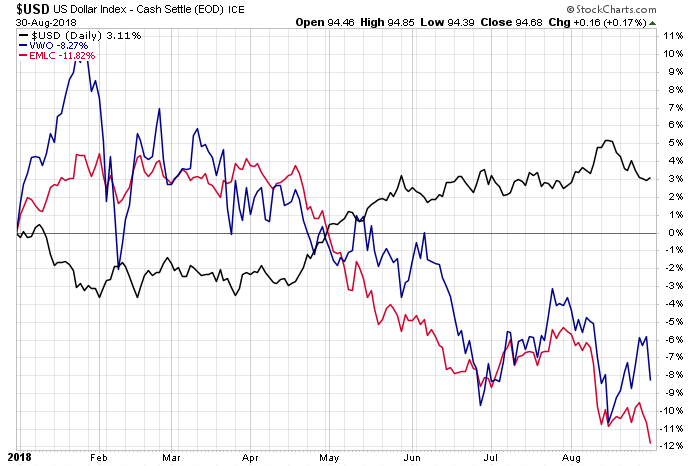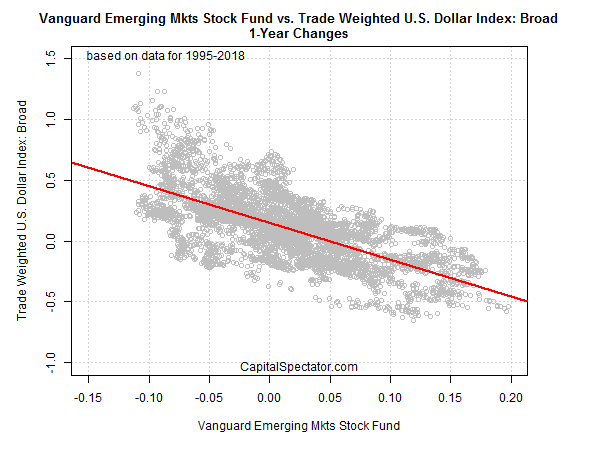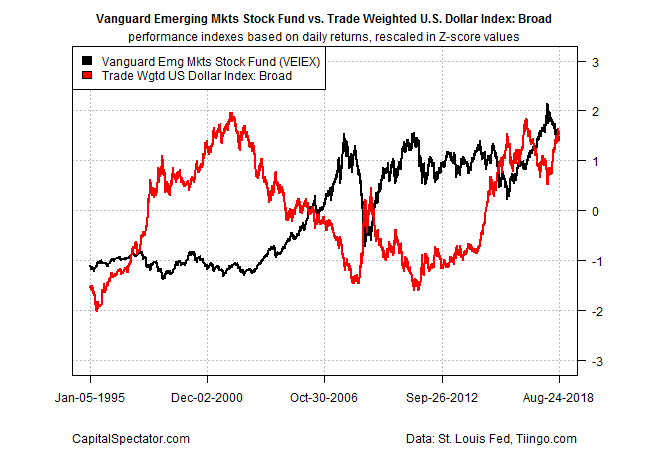It’s been a rough year for emerging markets. Stocks, bonds, and currencies in these countries have generally taken a hit in 2018. Not surprisingly, the US dollar has been strengthening.
The lesson, once again, is that investing in emerging markets requires monitoring the greenback’s trend. Although foreign exchange may not resonate as a relevant risk factor for some investors, there’s a strong case for making an exception when carving out a dedicated slot for emerging market assets in asset allocation.
Consider how the numbers stack up year to date. The US Dollar Index, which tracks the value of the United States dollar in terms of foreign currencies, is up around 3% this year through August 30. Meanwhile, ETFs targeting stocks and bonds in emerging markets — Vanguard FTSE Emerging Markets (VWO) and VanEck Vectors JP Morgan Emerging Markets Local Currency Bond (EMLC) – are down sharply so far in 2018. Note that the slide in VWO and EMLC accelerated as the US Dollar Index began to rally in the spring.

“A robust greenback is excellent for the US economy because it attracts capital into the economy. More capital will result in yet more growth,” Forbes noted recently. “But at the same time, the strong dollar is a nightmare for emerging markets because investors take their capital away and send it to the US.”
Let’s dig into this relationship a bit deeper for perspective, starting with a review of how daily returns correlate since 1995 for Vanguard Emerging Markets Stock (VEIEX) and the Trade Weighted U.S. Dollar Index: Broad. Not surprisingly, there’s a strong inverse link: the daily return correlation is -0.37 (Note: +1.0 is a perfect positive correlation, 0 is no correlation, and -1.0 marks a perfect negative correlation). The negative correlation is even deeper for one-year returns: -0.68.
Regressing the two sets of one-year performances reveals a relatively strong inverse connection: higher (lower) returns in the US dollar equate with lower (higher) changes in VEIEX.

The multiple R-squared on the data points in the chart above is 0.47. That reflects a moderately strong relationship. The implication: ignore the dollar trend at your own risk when investing in emerging markets.
For another perspective, let’s review how performance indexes (based on daily returns) stacks up for VEIEX and the US dollar. For a clearer picture of the relationship, the chart below rescales the performances in z-scores, which measures the number of standard deviations relative to the mean. It’s clear that the various dollar bull and bear regimes over the last 20-plus years have cast an influential shadow on returns in emerging market stocks.

For another view, consider how the relationship compares based on rolling one-year returns, which reveals a slightly more pronounced profile of the inverse link.

You shouldn’t set your watch to this relationship, but at the very least it’s prudent to periodically review the trend in the dollar for some context on what to expect for assets in emerging markets, if only for some insight regarding portfolio rebalancing. Quantitatively inclined investors may want to go deeper and model the relationship to generate expected returns.
To be clear, the US dollar is hardly the only factor to consider for portfolio design and management that includes allocations to emerging markets. But as the charts above suggest, ignoring the greenback may unintentionally elevate portfolio risk. That’s probably no big deal for investors with long-term horizons who have the discipline to look through short- and medium-term volatility. But if you’re risk tolerance is low and/or your investing with short-to-medium-term horizons, keeping an eye on the dollar trend should be part of your risk-management regimen if you have an allocation to emerging markets.
